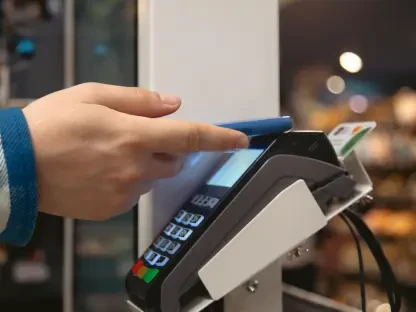Setting the Stage for a Retail Transformation
Imagine walking into a store where shelves are always stocked with exactly what you need, checkout lines move seamlessly without a scan, and personalized offers appear on your phone just as you browse. This is no longer a distant vision but a reality driven by the Artificial Intelligence of Things (AIoT), a powerful fusion of AI and IoT technologies that is transforming the retail landscape. In today’s retail environment, where rising costs and consumer expectations challenge even the most established players, AIoT stands as a game-changer, promising efficiency and innovation. Retailers across the UK, such as Tesco, Sainsbury’s, and Co-op, are already harnessing this technology to redefine how stores operate and engage with customers.
The retail industry is at a pivotal moment, grappling with issues like inventory mismanagement, retail crime, and the demand for faster, more tailored services. AIoT offers a pathway to address these hurdles by integrating smart devices, sensors, and data analytics into everyday operations. This report delves into how this convergence is reshaping modern retail, exploring its impact, emerging trends, challenges, and future potential. The focus is on actionable insights for industry stakeholders navigating a competitive and rapidly evolving market.
Understanding AIoT and Its Impact on Modern Retail
AIoT represents the synergy of Artificial Intelligence and the Internet of Things, enabling connected devices to not only collect data but also analyze and act on it in real time. In retail, this translates to smart shelves that detect low stock, cameras that monitor customer behavior, and systems that optimize energy use. The technology is transforming core areas such as inventory control, customer engagement, and operational streamlining, allowing retailers to respond swiftly to market demands and reduce inefficiencies.
The scope of AIoT in retail is vast, touching everything from predictive stock replenishment to personalized shopping experiences. By leveraging data from IoT-enabled tools, retailers gain insights into consumer patterns, enabling targeted promotions and faster service delivery. Operational efficiency also benefits, as automated processes cut down on manual tasks, saving time and reducing costs in an industry often squeezed by tight margins.
Prominent UK retailers like Tesco, Sainsbury’s, and Co-op are leading the charge, implementing AIoT solutions to tackle challenges such as rising operational expenses and heightened consumer expectations. These companies demonstrate the technology’s value in addressing systemic issues, from theft prevention to waste reduction. As a critical tool, AIoT helps the sector adapt to a landscape where agility and innovation are no longer optional but essential for survival.
Key Trends and Market Dynamics in AIoT-Driven Retail
Emerging Trends Shaping Retail Innovation
The retail sector is witnessing a surge in AIoT adoption, driven by technologies like predictive analytics, computer vision, and automation. Predictive tools forecast demand by analyzing sales data alongside external factors like weather, ensuring stores are neither overstocked nor underprepared. Meanwhile, computer vision aids in monitoring in-store activity, enhancing both security and customer service through real-time insights.
Consumer behavior is also shifting, with shoppers increasingly expecting personalized interactions and rapid service. AIoT meets these demands by enabling tailored recommendations via mobile apps and speeding up transactions through automated checkouts. This alignment with customer needs is a key driver, as retailers strive to maintain loyalty in a crowded market.
Market dynamics further fuel AIoT’s rise, with cost reduction, sustainability targets, and loss prevention acting as catalysts. As retail crime escalates, AIoT offers proactive solutions to safeguard assets, while energy management systems support eco-friendly goals. These factors create fresh opportunities for retailers to differentiate themselves, using smart technology as a competitive edge in an unforgiving industry.
Market Growth and Future Projections
Current data underscores AIoT’s growing footprint in retail, with the market valued at $171 million in 2025 and projected to soar to $2.7 billion by 2034. This exponential growth reflects the technology’s proven impact on key performance metrics, such as inventory accuracy and customer satisfaction. Reports indicate a 62% boost in productivity and a 63% increase in workforce satisfaction among businesses adopting these solutions.
Looking ahead, AIoT adoption is expected to scale significantly, with UK retailers setting a global standard. Their pioneering efforts in areas like smart inventory and checkout automation highlight a model for others to follow. The technology’s ability to deliver measurable outcomes ensures its place as a cornerstone of retail strategy in the coming years.
Beyond raw numbers, the momentum of AIoT signals a broader shift toward data-driven decision-making. Retailers investing now stand to gain long-term advantages, from streamlined operations to enhanced customer trust. As the market matures, the focus will likely expand to refining integration and maximizing returns on these sophisticated systems.
Challenges in Adopting AIoT for Retail Operations
Implementing AIoT in retail is not without hurdles, particularly when integrating with legacy systems. Many older infrastructures lack compatibility, necessitating open APIs to bridge the gap. This technical barrier can delay deployment and increase costs, posing a significant challenge for smaller retailers with limited resources.
Customer trust also remains a concern, as over-automation sometimes leads to dissatisfaction. Data shows a 15% rise in complaints for services relying solely on AI, highlighting the need for a human touch. Retailers must carefully balance technological efficiency with personal interaction to maintain positive shopper experiences and avoid alienating their base.
Data security and privacy issues loom large, especially with tools like facial recognition. Protecting sensitive information demands robust cybersecurity measures to prevent breaches and comply with regulations. Additionally, staff training is crucial to ensure employees can use AIoT tools effectively without workflow disruptions. Starting with pilot programs offers a practical solution, allowing retailers to test and refine systems before full-scale rollout.
Regulatory Landscape and Compliance in AIoT Retail Applications
The regulatory environment for AIoT in retail is evolving, with the UK’s Information Commissioner’s Office providing strict guidelines on data protection. These rules ensure that customer information gathered through smart devices is handled responsibly, safeguarding privacy while enabling innovation. Retailers must stay abreast of such frameworks to avoid penalties and maintain credibility.
New UK product security laws, effective since April 29, 2024, further shape the landscape by mandating compliance for manufacturers and distributors of connected devices. These regulations aim to secure IoT ecosystems against vulnerabilities, placing additional responsibility on industry players. Adherence to these standards is non-negotiable for lawful operation in the market.
Balancing innovation with privacy requires transparent policies and human oversight in automated systems. Retailers must communicate clearly how data is used and ensure customers have access to support when needed. Compliance not only fosters trust but also legitimizes operations, positioning businesses as reliable stewards of technology in a scrutinized sector.
The Future of AIoT in Retail: Opportunities and Disruptors
AIoT’s trajectory in retail points to exciting innovations, such as advanced checkout technologies and automated age estimation, as seen in initiatives by Co-op. These developments promise to further streamline transactions and ensure regulatory adherence for restricted sales. The potential for smarter, faster shopping experiences continues to drive investment in this space.
However, disruptors like shifting consumer preferences for hybrid human-AI interactions and intensifying regulatory scrutiny could alter the path forward. Retailers must adapt to these dynamics by offering flexible solutions that blend automation with personal service. Staying ahead of policy changes will also be critical to avoid operational setbacks.
Growth areas such as energy management for sustainability and supply chain optimization for scalability present untapped potential. External factors, including global economic conditions and competitive pressures, will influence how AIoT evolves. Technological advancements will likely accelerate adoption, provided retailers navigate these variables with strategic planning and foresight.
Reflecting on AIoT’s Journey and Path Forward
Looking back, this exploration of AIoT in retail revealed its profound capacity to enhance efficiency, personalize customer interactions, and address deep-rooted issues like theft and waste. The journey showcased how UK retailers led by example, turning challenges into opportunities through smart technology. Each step, from overcoming integration barriers to meeting regulatory demands, highlighted the importance of a measured approach.
Moving forward, retailers should prioritize targeted implementation, focusing on specific pain points like inventory or checkout delays before scaling up. Investing in staff training proved essential to ensure seamless adoption, while transparency in data practices built lasting customer trust. These actionable steps emerged as cornerstones for success in a complex landscape.
As the industry progresses, the need to anticipate economic shifts and technological breakthroughs becomes evident. Retailers who adapt proactively, leveraging AIoT for both operational gains and sustainability, position themselves as leaders. The path ahead demands continuous innovation, with a commitment to balancing automation’s benefits against privacy and human connection, ensuring retail remains both smart and relatable.









